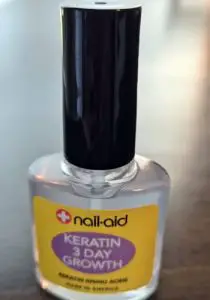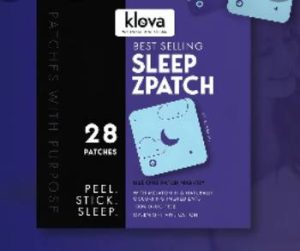If you’re chasing an even, radiant complexion without harsh ingredients, Cocokind’s Chlorophyll Discoloration Serum is your answer.
This vegan, sensitive skin-friendly serum tackles dark spots, redness, and uneven tone with a gentle yet effective formula.
After using it myself, I’m obsessed with its glowy results and affordable price. It’s a must-buy for anyone wanting brighter, calmer skin without breaking the bank. Grab it from Target or Cocokind’s site and see the magic for yourself!
My Experience with Cocokind Chlorophyll Discoloration Serum
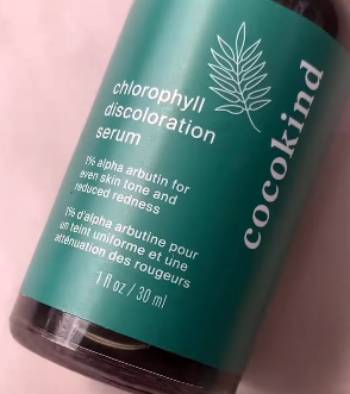
I’ve been on a mission to fade some stubborn dark spots from old acne and sun exposure, and let me tell you, it’s been a journey. My sensitive, oily skin doesn’t play nice with heavy or harsh products, so when I spotted Cocokind’s Chlorophyll Discoloration Serum at Target, I was intrigued.
Its green hue and promises of tackling discoloration with gentle ingredients like alpha-arbutin and chlorophyll had me sold. Plus, I’d already fallen in love with Cocokind’s Ceramide Barrier Serum, so I had high hopes.
The first time I used it, I applied one drop after cleansing and toning at night. The gel-like texture felt silky, almost like snail mucin but vegan, and it had a slight stickiness that dried down quickly.
My skin drank it up, leaving a subtle glow that made me feel fancy. By morning, the redness around my nose and chin was noticeably calmer—not gone, but definitely less angry. I was impressed but kept my expectations in check.
After two weeks of using it morning and night, I started seeing real changes. The dark spots on my cheeks were lighter, and my overall skin tone looked more even.
It layered beautifully under my moisturizer and sunscreen, no pilling in sight, which is a big win for my makeup days. Even during a breakout on my forehead, it soothed the redness without clogging my pores.
The only downside? I went through the bottle faster than I’d like, but a little goes a long way if you’re careful. This serum has earned a permanent spot in my routine, and I’m already eyeing my next bottle.
What Sets Cocokind Chlorophyll Discoloration Serum Apart
Cocokind’s serum is a powerhouse for sensitive skin. Its hero ingredient, 1% alpha-arbutin, gently fades dark spots and hyperpigmentation by reducing melanin production without the harshness of hydroquinone.
Chlorophyll, an antioxidant-rich plant pigment, offsets redness and adds radiance, perfect for no-makeup days. Licorice root enhances spot-fading, while panthenol (vitamin B5) soothes and hydrates.
The vegan formula mimics snail mucin’s glowy benefits without animal-derived ingredients, and it’s free of fragrance, essential oils, and common allergens.
Designed for daily use, it absorbs quickly and plays well with actives like retinol or AHAs, making it a versatile addition to any routine.
Maintenance Tips for Cocokind Chlorophyll Discoloration Serum
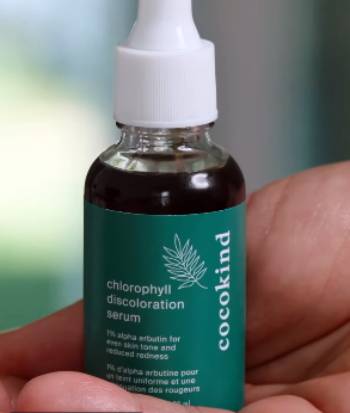
- Apply Sparingly to Avoid Pilling: Use only one or two drops to cover your face. I learned the hard way that overapplying can lead to pilling, especially under moisturizer or makeup. Pat it gently onto slightly damp skin after toning for better absorption and to reduce stickiness.
- Store in a Cool, Dry Place: Keep the bottle away from heat and humidity to preserve its potency. I store mine in a drawer, not my steamy bathroom, to ensure the ingredients stay active. The serum has a 12-month shelf life after opening, so check the “period after opening” symbol on the box.
- Layer Correctly for Best Results: Apply the serum after cleansing and toning but before heavier products like moisturizer or Cocokind’s Ceramide Barrier Serum. This lets the alpha-arbutin penetrate effectively. I give it a minute to dry before layering to avoid any tackiness or pilling.
- Use Consistently for 28 Days: Cocokind recommends daily use for at least 28 days to see results. I noticed lighter spots after two weeks, but consistency is key for fading stubborn discoloration. Use it morning and night, and don’t skip days if you want that even-toned glow.
- Recycle the Bottle Responsibly: The glass bottle is recyclable, but rinse it thoroughly and remove the dropper first. The plastic cap parts aren’t recyclable, so toss them separately. I love Cocokind’s sustainability focus—it feels good to reduce waste while caring for my skin.
Pros and Cons of Cocokind Chlorophyll Discoloration Serum
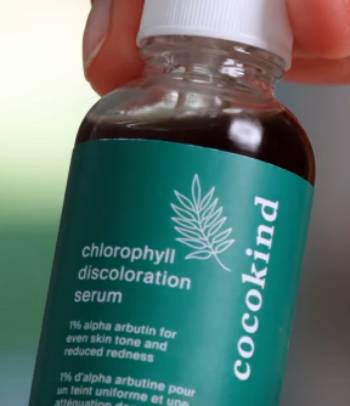
Pros:
- Gentle Yet Effective for Sensitive Skin: This serum is a godsend for my reactive skin. The fragrance-free, allergen-free formula doesn’t irritate, even during breakouts. Alpha-arbutin fades spots without the stinging or peeling I’ve gotten from harsher brighteners. It’s gentle enough for daily use, and my skin feels calm and happy.
- Reduces Redness and Discoloration: The chlorophyll works wonders on redness, especially around my nose and chin. After a few weeks, my dark spots from acne and sun damage were visibly lighter. My complexion looks more even, and I’ve gotten compliments on my “glow” from friends.
- Lightweight and Layerable: The gel texture absorbs fast, leaving no greasy residue. It layers seamlessly under moisturizer, sunscreen, or makeup without pilling, which is crucial for my oily skin. I can use it morning and night without feeling weighed down.
- Vegan and Cruelty-Free: I love that this serum is a vegan alternative to snail mucin, delivering similar hydrating and glowy benefits without harming animals. Cocokind’s commitment to clean, ethical skincare makes me feel good about my purchase.
- Affordable Price Point: At around $20, this serum delivers high-end results on a budget. The quality of ingredients like alpha-arbutin and licorice root rivals pricier brands, making it a steal for anyone wanting brighter skin without splurging.
Cons:
- Slightly Sticky Texture: The serum has a slight stickiness when you first apply it, which can feel tacky until it dries. It’s not a dealbreaker, but if you’re rushing through your routine, you might find it annoying. Waiting a minute before layering helps.
- Small Bottle Size: The 1-ounce bottle runs out quickly if you’re using it twice daily. I burned through mine in about a month, which caught me off guard. Using just one or two drops helps, but I wish it came in a larger size.
- Results Take Time: While I saw calmer redness overnight, fading dark spots took a few weeks. Cocokind recommends 28 days for best results, so don’t expect instant miracles. If you’re impatient, you might feel frustrated at first.
- Potential Pilling with Overuse: If I applied too much, especially on dry skin, it pilled under moisturizer or sunscreen. This only happened when I got heavy-handed, but it’s something to watch. Stick to the recommended one or two drops.
Also Read: My Thoughts On RoC Fill + Treat Serum
Cocokind Chlorophyll Discoloration Serum Vs. Other Brands
- Cocokind Chlorophyll Discoloration Serum Vs. The Ordinary Alpha Arbutin 2% + HA
The Ordinary’s Alpha Arbutin 2% + HA is a budget-friendly brightening serum with a higher alpha-arbutin concentration than Cocokind’s 1%. It’s effective for fading dark spots but feels watery and less hydrating, often leaving my skin tight. Cocokind’s chlorophyll and panthenol add soothing and glowy benefits, making it better for sensitive skin. The Ordinary’s formula can feel clinical and lacks the radiance boost I get from Cocokind. For a gentler, more nourishing experience, Cocokind wins, especially if redness is a concern.
- Cocokind Chlorophyll Discoloration Serum Vs. Paula’s Choice Discoloration Repair Serum
Paula’s Choice Discoloration Repair Serum combines tranexamic acid, niacinamide, and bakuchiol to tackle stubborn hyperpigmentation. It’s potent but thicker, sometimes feeling heavy on my oily skin. Cocokind’s lightweight gel absorbs faster and soothes redness better, thanks to chlorophyll. Paula’s Choice is pricier and can irritate sensitive skin, while Cocokind’s gentler alpha-arbutin suits daily use. If you need heavy-duty spot-fading, Paula’s Choice might edge out, but Cocokind’s affordability and comfort make it my daily go-to.
- Cocokind Chlorophyll Discoloration Serum Vs. Good Molecules Discoloration Correcting Serum
Good Molecules Discoloration Correcting Serum uses tranexamic acid and niacinamide to brighten and even skin tone. It’s affordable and effective but has a sticky texture that lingers longer than Cocokind’s. My sensitive skin occasionally tingled with Good Molecules, while Cocokind’s formula is consistently soothing. Cocokind’s chlorophyll adds a radiance boost that Good Molecules lacks. Both are great for budget-conscious shoppers, but Cocokind’s vegan, redness-reducing formula feels more luxurious and versatile for all skin types.
- Cocokind Chlorophyll Discoloration Serum Vs. Naturium Alpha Arbutin Serum 2%
Naturium’s Alpha Arbutin Serum 2% pairs alpha-arbutin with niacinamide for potent spot-fading. It’s hydrating but has a denser texture that felt heavy in humid weather. Cocokind’s serum is lighter and better for oily skin, with chlorophyll soothing redness more effectively. Naturium’s higher alpha-arbutin dose might work faster for stubborn spots, but it irritated my sensitive skin slightly. Cocokind’s gentler approach and vegan formula make it a better fit for daily use, especially if you want glow without greasiness.
- Cocokind Chlorophyll Discoloration Serum Vs. Drunk Elephant C-Firma Fresh Day Serum
Drunk Elephant’s C-Firma Fresh Day Serum blends vitamin C, ferulic acid, and pumpkin ferment for brightening and anti-aging. It’s a splurge and feels sticky, often pilling under sunscreen. Cocokind’s serum is lighter, cheaper, and soothes redness with chlorophyll, which Drunk Elephant lacks. While C-Firma targets fine lines better, it irritated my sensitive skin. Cocokind’s alpha-arbutin focuses on discoloration with less fuss, making it ideal for budget-friendly, gentle brightening. If you want affordability and comfort, Cocokind is the clear winner.
Also Read: My Thoughts On The Ordinary Niacinamide Serum
Frequently Asked Questions (FAQs)
Cocokind’s Chlorophyll Discoloration Serum fades dark spots, post-blemish marks, and UV damage with 1% alpha-arbutin. Chlorophyll reduces redness and boosts radiance, while panthenol and licorice root soothe and brighten. It hydrates, evens skin tone, and leaves a healthy glow, making it ideal for sensitive skin seeking a brighter complexion.
Yes, chlorophyll helps with discoloration by offsetting redness and boosting radiance, complementing alpha-arbutin’s spot-fading power. While alpha-arbutin does the heavy lifting, chlorophyll’s antioxidants calm irritated skin, making discoloration less noticeable. It’s especially great for redness-prone skin, enhancing overall tone.
Cocokind recommends using the serum daily for at least 28 days for optimal results. I saw reduced redness overnight and lighter dark spots after two weeks. Stubborn hyperpigmentation may take a month or more to fade significantly, so patience and consistency are key.
The serum plays well with most actives like retinol, AHAs, or niacinamide, but patch-test first to avoid irritation. Avoid layering with heavy oils or thick creams that might block absorption. I also skip harsh exfoliants on the same day to prevent sensitivity, ensuring the serum works effectively.
Final Thoughts
I can’t stop raving about Cocokind’s Chlorophyll Discoloration Serum. It’s gentle, affordable, and delivers real results for fading dark spots and calming redness.
Whether you’re new to skincare or a seasoned pro, this vegan gem fits seamlessly into your routine. Pick it up at Target or Cocokind’s website and watch your skin glow. You won’t regret it!

